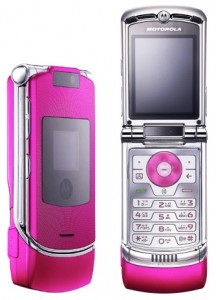A couple years back in 2004 when the Mortorola Razr was first introduced, it caught everyone’s attention. The razr’s unique, thin and light design made it stand out from other flip-phones. It varied in many colors, including a very popular hot pink color and everyone wanted one. Over time, new technology had introduced smart phones and this is where Mortorala ran into a huge issue.
When the razr hit the growth stage of the product cycle; they kept the same design but would add to it. It was a flip phone that had a camera, was able to send and receive emails, and although a bit slow you could surf the web. The reason they kept the design the same was because it was known for its design. People loved the Razr for that reason and it was known for being the best flip-phone out there.
As this product matured there was fewer changes made because there was not much that could be changed with the design since it was known for its cool look. This is where the issue was because touch screen phones were now a hot product for consumers and Motorola was behind. “We didn’t look at what’s going to disrupt [the RAZR],” Wicks says. “Someone else was. We didn’t invest in disrupting our own leadership.” And even when Motorola did try to evolve and improve, it met resistance from the all-powerful carriers. “We got caught in that bad spot where we were locked into our next-generation product lines and specs based on everyone saying ‘we want the same thing,’ and once we were locked in everyone started to say ‘yeah, but that looks just like the RAZR.’ Then the iPhone came out, and marked another shift in the phone industry.”(“Status Symbols: Motorola RAZR.” ). Motorola was not prepared for the introduction of smart phones and did not know how to approach the situation. While Motorola attempted to change the Razr people kept saying they want the same thing and when they got the same thing they were not satisfied. Motorola was stuck in place and people started switching over to other companies. I believe that it was contradicting information for Mortorola because when they tried to compete with other companies and also satisfy consumers it didn’t work. Consumers did not like the fact that the new Motorola phone looked the Razr but yet were buying smart phones from Apple and Samsung. “A 2008 report revealed that 24 percent of new iPhone owners in the U.S. switched from the Razr.” (“Remembering the Razr: The Device That Snapped Shut the Era of Flip Phones”). Consumers were clearly interested in trying a new product that did not resemble the Razr. This is where Motorola should have come up with a plan that would lure back their loyal consumers who indeed loved the Razr. They should have strategized in a way to target their loyal customers as well as new consumers. They were at a great advantage because the Razr was a hit a point and their next product could have also succeeded if it were marketed the right way.
In 2011, Mortorola had introduced the Droid Razr Maxx and it failed. They did not do a great job of marketing and trying to get consumers to switch over because I haven’t even heard of it before. They did not market themselves well and were competing against Samsung and Apple both major companies. “Motorola learned that companies have to excel at engineering, design, and marketing, he says, or they’ve got nothing.”(“Status Symbols: Motorola RAZR.” ). It’s true, in order to succeed you must do well at the engineering, design, and marketing part which Mortorla did not do and for that reason they declined.
Have you heard of the Driod Razr Maxx when it came out? How could have Motorola marketed to attract consumers?
Sources:
“Remembering the Razr: The Device That Snapped Shut the Era of Flip Phones.” Digital Trends. N.p., n.d. Web. 23 Oct. 2014.<http://www.digitaltrends.com/mobile/ghosts-of-christmas-past-the-original-motorola-razr/>.
“Status Symbols: Motorola RAZR.” The Verge. N.p., n.d. Web. 23 Oct. 2014. <http://www.theverge.com/2013/10/3/4798828/status-symbol-motorola-razr>.
